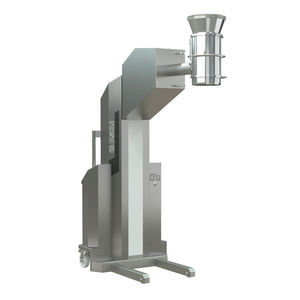
- Medical & Pharmaceutical industry
- Pharmaceutical industry
- Hammer mill
- L.B. Bohle Maschinen und Verfahren GmbH
- Company
- Products
- Catalogs
- News & Trends
- Exhibitions
Batch mill BTM hammerknifepharmaceutical industry
Add to favorites
Compare this product
Characteristics
- Technology
- batch, hammer, knife
- Applications
- pharmaceutical industry, for research and development
- Other characteristics
- continuous, automatic
Description
Mills are used for milling solids. This milling fulfils two purposes: First, it enlarges the particle surface which increases the speed of dissolution. Second, it evens out differences between particle sizes in order to ensure that mixing can be homogeneous.
Due to their versatility, sieving machine mills play a crucial role in pharmaceutical chemical and food production. They can be integrated into complex production lines, for example for filling/emptying or transfer operations at process machines, or for filling and decanting containers (IBCs).
Arguments for use of mills:
high functionality
very small footprint
In particular in pharmaceutical clean rooms where there is often not much space, the small footprint of these systems is a great benefit. Hammer mills can also be equipped with an integrated lifting column so that they can be integrated into almost any conceivable process scenario.
Another feature that increases the efficiency of the processes is the mobility of the machines. For use or for cleaning, they can be moved or even disassembled quickly and easily.
Hammer or turbo mills are suitable for research and development, as well as for batch production or continuous manufacturing. They are used for the milling of powders, agglomerates, and granules. Hammer mills are used in particular if the application demands a precise particle reduction for hard-to-mill active ingredients and other substances. In addition, hammer mills are used to re-mill fragmented tablets.
Catalogs
Product Portfolio
7 Pages
Other L.B. Bohle Maschinen und Verfahren GmbH products
Grinding & Sieving
Related Searches
- Agitator
- Blender
- Pharmaceutical industry grinder
- Laboratory crusher
- Rotary blender
- Industrial mixer
- L.B. Bohle Maschinen + Verfahren GmbH granulator for the pharmaceutical industry
- Blender for the pharmaceutical industry
- Coater for the pharmaceutical industry
- Rotor grinder
- Film coater
- Batch mill
- Floor-standing coating machine
- Wet granulator
- Dryer granulator
- Tablet coater
- Continuous crusher
- Powder blender
- Dry granulator
- Cutting mill
*Prices are pre-tax. They exclude delivery charges and customs duties and do not include additional charges for installation or activation options. Prices are indicative only and may vary by country, with changes to the cost of raw materials and exchange rates.




